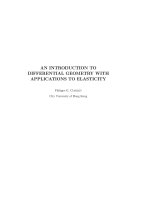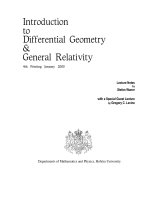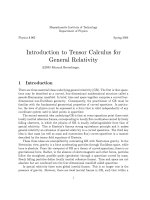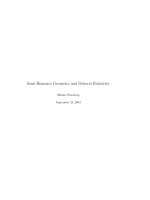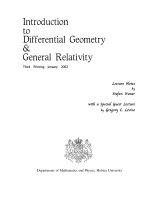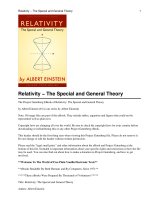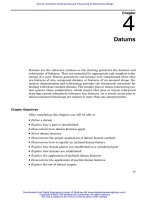Intro to Differential Geometry and General Relativity - S. Warner Episode 4 ppsx
Bạn đang xem bản rút gọn của tài liệu. Xem và tải ngay bản đầy đủ của tài liệu tại đây (60.43 KB, 10 trang )
31
(b) Let ˙ be a scalar field. Its ambient gradient, grad
˙, is given by
grad
˙ = [
∂˙
∂y
1
, , . . . ,
∂˙
∂y
s
],
that is, the garden-variety gradient you learned about in calculus. This gradient is, in
general, neither covariant or contravariant. However, we can use it to obtain a 1-form as
follows: If VV
VV
is any contravariant vector field, then the rate of change of ˙ along VV
VV
is given
by VV
VV
.grad
˙. (If VV
VV
happens to be a unit vector at some point, then this is the directional
derivative at that point.) In other words, dotting with grad
˙ assigns to each contravariant
vector field the scalar field
F(vv
vv
) = VV
VV
.grad
˙ which tells it how fast ˙ is changing along VV
VV
.
We also get the 1-form identities:
F(VV
VV
+WW
WW
) = F(VV
VV
) + F(WW
WW
)
F(åVV
VV
) = åF(VV
VV
).
The coordinates of the corresponding covariant vector field are
F(∂/∂x
i
) = (∂/∂x
i
)
grad ˙
= [
∂y
1
∂x
i
,
∂y
2
∂x
i
, . . . ,
∂y
s
∂x
i
] . [
∂˙
∂y
1
, , . . . ,
∂˙
∂y
s
],
=
∂˙
∂x
i
,
which is the example that first motivated the definition.
(c) Generalizing (b), let ££
££
be any smooth vector field (in E
s
) defined on M. Then the
operation of dotting with ££
££
is a linear function from smooth tangent fields on M to smooth
scalar fields. Thus, it is a cotangent field on M with local coordinates given by applying the
linear function to the canonical charts ∂/∂x
i
:
C
i
=
∂
∂x
i
·££
££
.
The gradient is an example of this, since we are taking
££
££
==
==
grad ˙
in the preceding example.
Note that, in general, dotting with ££
££
depends only on the tangent component of ££
££
. This
leads us to the next example.
(d) If V is any tangent (contravariant) field, then we can appeal to (c) above and obtain an
associated covariant field. The coordinates of this field are not the same as those of V. To
find them, we write:
VV
VV
= V
i
∂
∂x
i
(See Note 4.2 (4).)
32
Hence,
C
j
=
∂
∂x
j
·V
i
∂
∂x
i
= V
i
∂
∂x
j
·
∂
∂x
i
.
Note that the tangent vectors ∂/∂x
i
are not necessarily orthogonal, so the dot products don't
behave as simply as we might suspect. We let g
ij
=
∂
∂x
j
·
∂
∂x
i
, so that
C
j
= g
ij
V
i
.
We shall see the quantities g
ij
again presently.
Definition 4.9 If V and W are contravariant (or covariant) vector fields on M, and if å is a
real number, we can define new fields V+W and åV by
(V + W)
i
= V
i
+ W
i
and (åV)
i
= åV
i
.
It is easily verified that the resulting quantities are again contravariant (or covariant) fields.
(Exercise Set 4). For contravariant fields, these operations coincide with addition and scalar
multiplication as we defined them before.
These operations turn the set of all smooth contravariant (or covariant) fields on M into a
vector space. Note that we cannot expect to obtain a vector field by adding a covariant field
to a contravariant field.
Exercise Set 4
1. Suppose that X
j
is a contravariant vector field on the manifold M with the following
property: at every point m of M, there exists a local coordinate system x
i
at m with X
j
(x
1
, x
2
,
. . . , x
n
) = 0. Show that X
i
is identically zero in any coordinate system.
2. Give and example of a contravariant vector field that is not covariant. Justify your claim.
3. Verify the following claim If V and W are contravariant (or covariant) vector fields on M,
and if å is a real number, then V+W and åV are again contravariant (or covariant) vector
fields on M.
4. Verify the following claim in the proof of Proposition 4.7: If C
i
is covariant and V
j
is
contravariant, then C
k
V
k
is a scalar.
5. Let ˙: S
n
’E
1
be the scalar field defined by ˙(p
1
, p
2
, . . . , p
n+1
) = p
n+1
.
(a) Express ˙ as a function of the x
i
and as a function of the x–
j
.
(b) Calculate C
i
= ∂˙/∂x
i
and C—
j
= ∂˙/∂x–
j
.
(c) Verify that C
i
and C—
j
transform according to the covariant vector transformation rules.
6. Is it true that the quantities x
i
themselves form a contravariant vector field? Prove or give
a counterexample.
7. Prove that § and ∞ in Proposition 4.7 are inverse functions.
8. Prove: Every covariant vector field is of the type given in Example 4.8(d). That is,
obtained from the dot product with some contrravariant field.
33
5. Tensor Fields
Suppose that vv
vv
= “v
1
, v
2
, v
3
‘ and ww
ww
= “w
1
, w
2
, w
3
‘ are vector fields on E
3
. Then their
tensor product is defined to consist of the nine quantities v
i
w
j
. Let us see how such things
transform. Thus, let V and W be contravariant, and let C and D be covariant. Then:
V—
i
W—
j
=
∂x–
i
∂x
k
V
k
∂x–
j
∂x
l
W
l
=
∂x–
i
∂x
k
∂x–
j
∂x
l
V
k
W
l
,
and similarly,
V—
i
C—
j
=
∂x–
i
∂x
k
∂x
l
∂x–
j
V
k
C
l
,
and
C—
i
D—
j
=
∂x
k
∂x–
i
∂x
l
∂x–
j
C
k
D
l .
We call these fields “tensors” of type (2, 0), (1, 1), and (0, 2) respectively.
Definition 5.1 A tensor field of type (2, 0) on the n-dimensional smooth manifold M
associates with each chart x a collection of n
2
smooth functions T
ij
(x
1
, x
2
, . . . , x
n
) which
satisfy the transformation rules shown below. Similarly, we define tensor fields of type (0,
2), (1, 1), and, more generally, a tensor field of type (m, n).
Some Tensor Transformation Rules
Type (2, 0): T—
ij
=
∂x–
i
∂x
k
∂x–
j
∂x
l
T
kl
Type (1, 1): M—
i
j
=
∂x–
i
∂x
k
∂x
l
∂x–
j
M
k
l
Type (0, 2): S—
ij
=
∂x
k
∂x–
i
∂x
l
∂x–
j
S
kl
Notes
(1) A tensor field of type (1, 0) is just a contravariant vector field, while a tensor field of
type (0, 1) is a covariant vector field. Similarly, a tensor field of type (0, 0) is a scalar field.
Type (1, 1) tensors correspond to linear transformations in linear algebra.
(2) We add and scalar multiply tensor fields in a manner similar to the way we do these
things to vector fields. For instant, if A and B are type (1,2) tensors, then their sum is
given by
(A+B)
ab
c
= A
ab
c
+ B
ab
c
.
Examples 5.2
(a) Of course, by definition, we can take tensor products of vector fields to obtain tensor
fields, as we did above in Definition 4.1.
34
(b) The Kronecker Delta Tensor, given by
©
i
j
=
1 if j=i
0 ifj≠i
is, in fact a tensor field of type (1, 1). Indeed, one has
©
i
j
=
∂x
i
∂x
j
,
and the latter quantities transform according to the rule
©—
i
j
=
∂x–
i
∂x–
j
=
∂x–
i
∂x
k
∂x
k
∂x
l
∂x
l
∂x–
j
=
∂x–
i
∂x
k
∂x
l
∂x–
j
©
k
l
,
whence they constitute a tensor field of type (1, 1).
Notes
1. ©
i
j
= ©—
i
j
as functions on E
n
. Also, ©
i
j
= ©
j
i
. That is, it is a symmetric tensor.
2.
∂x–
i
∂x
j
∂x
j
∂x–
k
=
∂x–
i
∂x–
k
= ©
i
k
.
Question OK, so is this how it works: Given a point p of the manifold and a chart x at p
this strange object assigns the n
2
quantities ©
i
j
; that is, the identity matrix, regardless of
the chart we chose?
Answer Yes.
Question But how can we interpret this strange object?
Answer Just as a covariant vector field converts contravariant fields into scalars (see
Section 3) we shall see that a type (1,1) tensor converts contravariant fields to other
contravariant fields. This particular tensor does nothing: put in a specific vector field V, out
comes the same vector field. In other words, it is the identity transformation.
(c) We can make new tensor fields out of old ones by taking products of existing tensor
fields in various ways. For example,
M
i
jk
N
pq
rs
is a tensor of type (3, 4),
while
M
i
jk
N
jk
rs
is a tensor of type (1, 2).
Specific examples of these involve the Kronecker delta, and are in the homework.
(d) If X is a contravariant vector field, then the functions
∂X
i
∂x
j
do not define a tensor.
Indeed, let us check the transformation rule directly:
∂X—
i
∂x–
j
=
∂
∂x–
j
X
k
∂x–
i
∂x
k
=
∂
∂x
h
X
k
∂x–
i
∂x
k
∂x
h
∂x–
j
=
∂X
k
∂x
h
∂x–
i
∂x
k
∂x
h
∂x–
j
+ X
k
∂
2
x–
i
∂x
h
∂x
K
35
The extra term on the right violates the transformation rules.
We will see more interesting examples later.
Proposition 5.3 (If It Looks Like a Tensor, It Is a Tensor)
Suppose that we are given smooth local functions g
ij
with the property that for every pair of
contravariant vector fields X
i
and Y
i
, the smooth functions g
ij
X
i
Y
j
determine a scalar field,
then the g
ij
determine a smooth tensor field of type (0, 2).
Proof Since the g
ij
X
i
Y
j
form a scalar field, we must have
g–
ij
X—
i
Y—
j
= g
hk
X
h
Y
k
.
On the other hand,
g–
ij
X—
i
Y—
j
= g–
ij
X
h
Y
k
∂x–
i
∂x
h
∂x–
j
∂x
k
.
Equating the right-hand sides gives
g
hk
X
h
Y
k
= g–
ij
∂x–
i
∂x
h
∂x–
j
∂x
k
X
h
Y
k
(I)
Now, if we could only cancel the terms X
h
Y
k
. Well, choose a point m é M. It suffices to
show that g
hk
= g–
ij
∂x–
i
∂x
h
∂x–
j
∂x
k
, when evaluated at the coordinates of m. By Example 4.3(c),
we can arrange for vector fields X and Y such that
X
i
(coordinates of m) =
1 if i=h
0 otherwise
,
and
Y
i
(coordinates of m) =
1 ifi=k
0 otherwise
.
Substituting these into equation (I) now gives the required transformation rule. ◆
Example 5.4 Metric Tensor
Define a set of quantities g
ij
by
g
ij
=
∂
∂x
j
·
∂
∂x
i
.
If X
i
and Y
j
are any contravariant fields on M, then XX
XX
·YY
YY
is a scalar, and
XX
XX
·YY
YY
= X
i
∂
∂x
i
·Y
j
∂
∂x
j
= g
ij
X
i
Y
j
.
Thus, by proposition 4.3, it is a type (0, 2) tensor. We call this tensor “the metric tensor
inherited from the imbedding of M in E
s
.”
Exercise Set 5
1. Compute the transformation rules for each of the following, and hence decide whether or
not they are tensors. Sub-and superscripted quantities (other than coordinates) are
understood to be tensors.
36
(a)
dX
i
j
dt
(b)
∂x
i
∂x
j
(c)
∂X
i
∂x
j
(d)
∂
2
˙
∂x
i
∂x
j
(e)
∂
2
x
l
∂x
i
∂x
j
22
22
(Rund, p. 95 #3.4) Show that if A
j
is a type (0, 1) tensor, then
∂A
j
∂x
h
-
∂A
h
∂x
j
is a type (0, 2) tensor.
3. Show that, if M and N are tensors of type (1, 1), then:
(a) M
i
j
N
p
q
is a tensor of type (2, 2)
(b) M
i
j
N
j
q
is a tensor of type (1, 1)
(c) M
i
j
N
j
i
is a tensor of type (0, 0) (that is, a scalar field)
4. Let X be a contravariant vector field, and suppose that M is such that all change-of-
coordinate maps have the form x–
i
= a
ij
x
j
+ k
i
for certain constants a
ij
and k
j
. (We call such a
manifold affine.) Show that the functions
∂X
i
∂x
j
define a tensor field of type (1, 1).
5. (Rund, p. 96, 3.12) If B
ijk
= -B
jki
, show that B
ijk
= 0. Deduce that any type (3, 0)
tensor that is symmetric on the first pair of indices and skew-symmetric on the last pair of
indices vanishes.
6. (Rund, p. 96, 3.16) If A
kj
is a skew-symmetric tensor of type (0, 2), show that the
quantities B
rst
defined by
B
rst
=
∂A
st
∂x
r
+
∂A
tr
∂x
s
+
∂A
rs
∂x
t
(a) are the components of a tensor; and
(b) are skew-symmetric in all pairs in indices.
(c) How many independent components does B
rst
have?
7. Cross Product
(a) If X and Y are contravariant vectors, then their cross-product is defined as the tensor of
type (2, 0) given by
(X … Y)
ij
= X
i
Y
j
- X
j
Y
i
.
Show that it is a skew-symmetric tensor of type (2, 0).
(b) If M = E
3
, then the totally antisymmetric third order tensor is defined by
œ
ijk
=
1 if (i,j,k) is an even permutation of (1,2,3)
-1 if it is an odd permutation of (1,2,3)
(or equivalently, œ
123
= +1, and œ
ijk
is skew-symmetric in every pair of indices.) Then, the
(usual) cross product on E
3
is defined by
(X ¿ Y)
i
= œ
ijk
(X … Y)
jk
.
(c) What goes wrong when you try to define the “usual” cross product of two vectors on
E
4
? Is there any analogue of (b) for E
4
?
8. Suppose that C
ij
is a type (2, 0) tensor, and that, regarded as an n¿n matrix C, it
happens to be invertible in every coordinate system. Define a new collection of functions,
D
ij
by taking
37
D
ij
= C
-1
ij
,
the ij the entry of C
-1
in every coordinate system. Show that D
ij
, is a type (0, 2) tensor.
[Hint: Write down the transformation equation for C
ij
and invert everything in sight.]
9. What is wrong with the following “proof” that
∂
2
x
j–
∂x
h
∂x
k
= 0 regardless of what smooth
functions x–
j
(x
h
) we use:
∂
2
x
j–
∂x
h
∂x
k
=
∂
∂x
h
∂x–
j
∂x
k
Definition of the second derivative
=
∂
∂x–
l
∂x–
j
∂x
k
∂x–
l
∂x
h
Chain rule
=
∂
2
x
j–
∂x–
l
∂x
k
∂x–
l
∂x
h
Definition of the second derivative
=
∂
2
x
j–
∂x
k
∂x–
l
∂x–
l
∂x
h
Changing the order of differentiation
=
∂
∂x
k
∂x–
j
∂x–
l
∂x–
l
∂x
h
Definition of the second derivative
=
∂
∂x
k
©
i
l
∂x–
l
∂x
h
Since
∂x–
j
∂x–
l
= ©
i
l
= 0 Since ©
i
l
is constant!
6. Riemannian Manifolds
Definition 6.1 A smooth inner product on a manifold M is a function “-,-‘ that
associates to each pair of smooth contravariant vector fields X and Y a scalar (field) “X, Y‘,
satisfying the following properties.
Symmetry: “X, Y‘ = “Y, X‘ for all X and Y,
Bilinearity: “åX, ∫Y‘ = å∫“X, Y‘ for all X and Y, and scalars å and ∫
“X, Y+Z‘ = “X, Y‘ + “X, Z‘
“X+Y, Z‘ = “X, Z‘ + “Y, Z‘.
Non-degeneracy: If “X, Y‘ = 0 for every Y, then X = 0.
We also call such a gizmo a symmetric bilinear form. A manifold endowed with a smooth
inner product is called a Riemannian manifold.
Before we look at some examples, let us see how these things can be specified. First,
notice that, if xx
xx
is any chart, and p is any point in the domain of xx
xx
, then
“X, Y‘ = X
i
Y
j
“
∂
∂x
i
,
∂
∂x
j
‘.
This gives us smooth functions
g
ij
= “
∂
∂x
i
,
∂
∂x
j
‘
such that
“X, Y‘ = g
ij
X
i
Y
j
38
and which, by Proposition 5.3, constitute the coefficients of a type (0, 2) symmetric
tensor. We call this tensor the fundamental tensor or metric tensor of the Riemannian
manifold.
Examples 6.2
(a) M = E
n
, with the usual inner product; g
ij
= ©
ij
.
(b) (Minkowski Metric) M = E
4
, with g
ij
given by the matrix
G =
100 0
010 0
001 0
000-c
2
,
where c is the speed of light.
Question How does this effect the length of vectors?
Answer We saw in Section 3 that, in E
n
, we could think of tangent vectors in the usual
way; as directed line segments starting at the origin. The role that the metric plays is that it
tells you the length of a vector; in other words, it gives you a new distance formula:
Euclidean 3- space: d(x, y) =
(y
1
-x
1
)
2
+(y
2
-x
2
)
2
+(y
3
-x
3
)
2
Minkowski 4-space: d(x, y) =
(y
1
-x
1
)
2
+(y
2
-x
2
)
2
+(y
3
-x
3
)
2
-c
2
(y
4
-x
4
)
2
.
Geometrically, the set of all points in Euclidean 3-space at a distance r from the origin (or
any other point) is a sphere of radius r. In Minkowski space, it is a hyperbolic surface. In
Euclidean space, the set of all points a distance of 0 from the origin is just a single point; in
M, it is a cone, called the light cone. (See the figure.)
39
x
4
Euclidean 3-space
x , x , x
12 3
Light Cone
(c) If M is any manifold embedded in E
s
, then we have seen above that M inherits the
structure of a Riemannian metric from a given inner product on E
s
. In particular, if M is any
3-dimensional manifold embedded in E
4
with the metric shown above, then M inherits such
a inner product.
(d) As a particular example of (c), let us calculate the metric of the two-sphere M = S
2
,
with radius r, using polar coordinates x
1
= ø, x
2
= ˙. To find the coordinates of g
**
we
need to calculate the inner product of the basis vectors ∂/∂x
1
, ∂/∂x
2
. We saw in Section 3
that the ambient coordinates of ∂/∂x
i
are given by
j th coordinate =
∂y
j
∂x
i
,
where
y
1
= r sin(x
1
)
cos(x
2
)
y
2
= r sin(x
1
)
sin(x
2
)
y
3
= r cos(x
1
)
Thus,
∂
∂x
1
= r(cos(x
1
)cos(x
2
), cos(x
1
)sin(x
2
), -sin(x
1
))
∂
∂x
2
= r(-sin(x
1
)sin(x
2
), sin(x
1
)cos(x
2
), 0)
This gives
40
g
11
= “∂/∂x
1
, ∂/∂x
1
‘ = r
2
g
22
= “∂/∂x
2
, ∂/∂x
2
‘ = r
2
sin
2
(x
1
)
g
12
= “∂/∂x
1
,∂/∂x
2
‘ = 0,
so that
g
**
=
r
2
0
0r
2
sin
2
(x
1
)
.
(e) The nn
nn
-Dimensional Sphere Let M be the n-sphere of radius r with the followihg
generalized polar coordinates.
y
1
= r cos x
1
y
2
= r sin x
1
cos x
2
y
3
= r sin x
1
sin x
2
cos x
3
…
y
n-1
= r sin x
1
sin x
2
sin x
3
sin x
4
… cos x
n-1
y
n
= r sin x
1
sin x
2
sin x
3
sin x
4
… sin x
n-1
cos x
n
y
n+1
= r sin x
1
sin x
2
sin x
3
sin x
4
… sin x
n-1
sin x
n
.
(Notice that x
1
is playing the role of ˙ and the x
2
, x
3
, . . . , x
n-1
the role of ø.) Following the
line of reasoning in the previous example, we have
∂
∂x
1
= (-r sin x
1
, r cos x
1
cos x
2
, r cos x
1
sin x
2
cos x
3
, . . . ,
r
cos x
1
sin x
2
… sin x
n-1
cos x
n
, r cos x
1
sin x
2
… sin x
n-1
sin x
n
)
∂
∂x
2
= (0, -r sin x
1
sin x
2
, . . . , r sin x
1
cos x
2
sin x
3
… sin x
n-1
cos x
n
,
r
sin x
1
cos x
2
sin x
3
… sin x
n-1
sin x
n
).
∂
∂x
3
= (0, 0, -r sin x
1
sin x
2
sin x
3
, r sin x
1
sin x
2
cos x
3
cos x
4
. . . ,
r
sin x
1
sin x
2
cos x
3
sin x
4
… sin x
n-1
cos x
n
, r sin x
1
sin x
2
cos x
3
sin x
4
… sin x
n-1
sin
x
n
),
and so on.
g
11
= “∂/∂x
1
, ∂/∂x
1
‘ = r
2
g
22
= “∂/∂x
2
, ∂/∂x
2
‘ = r
2
sin
2
x
1
g
33
= “∂/∂x
3
, ∂/∂x
3
‘ = r
2
sin
2
x
1
sin
2
x
2
